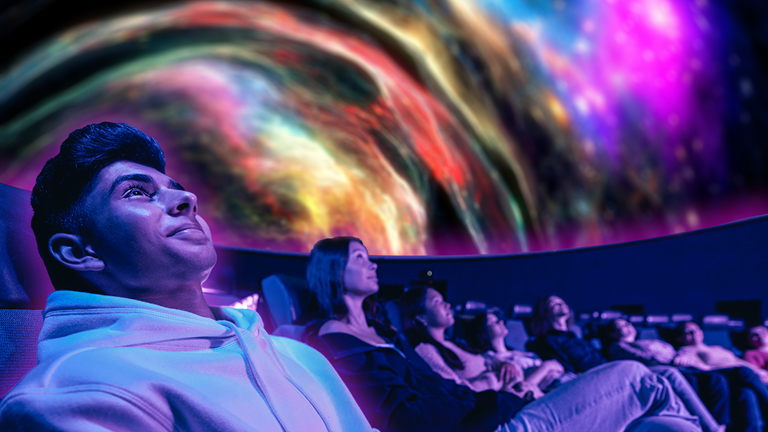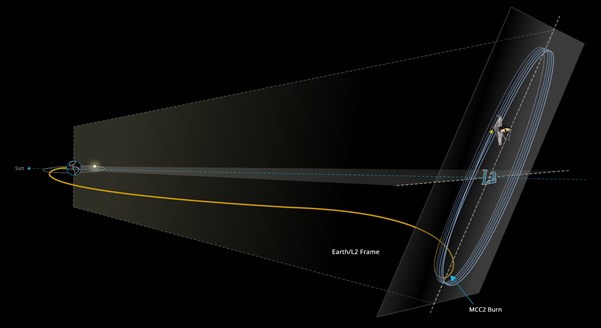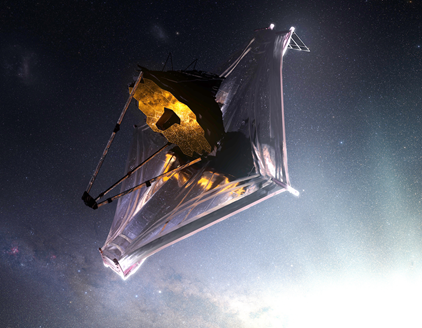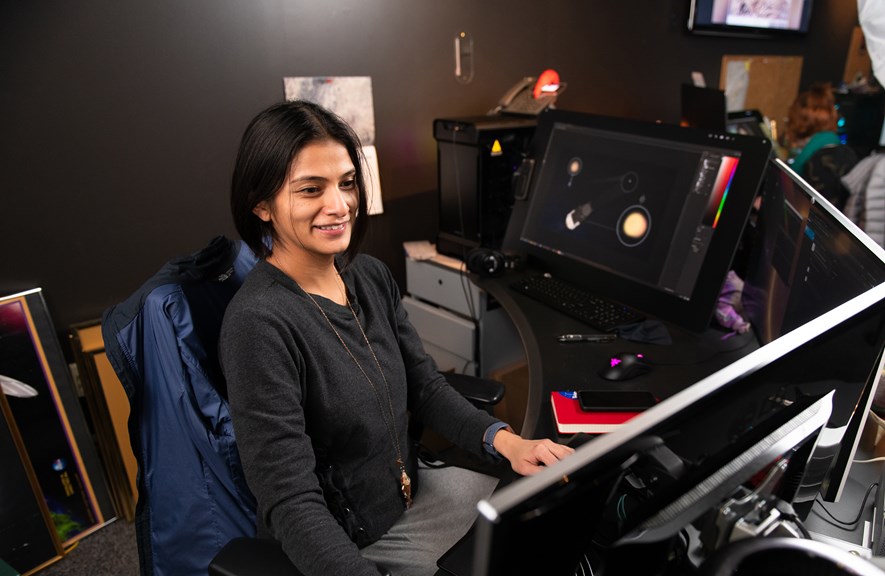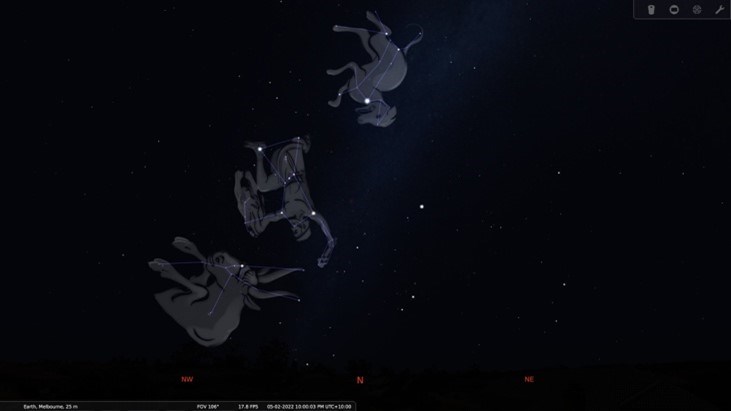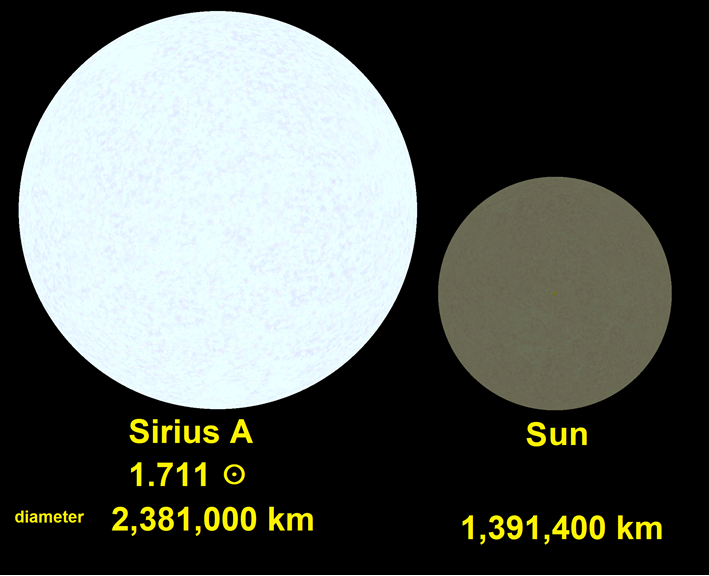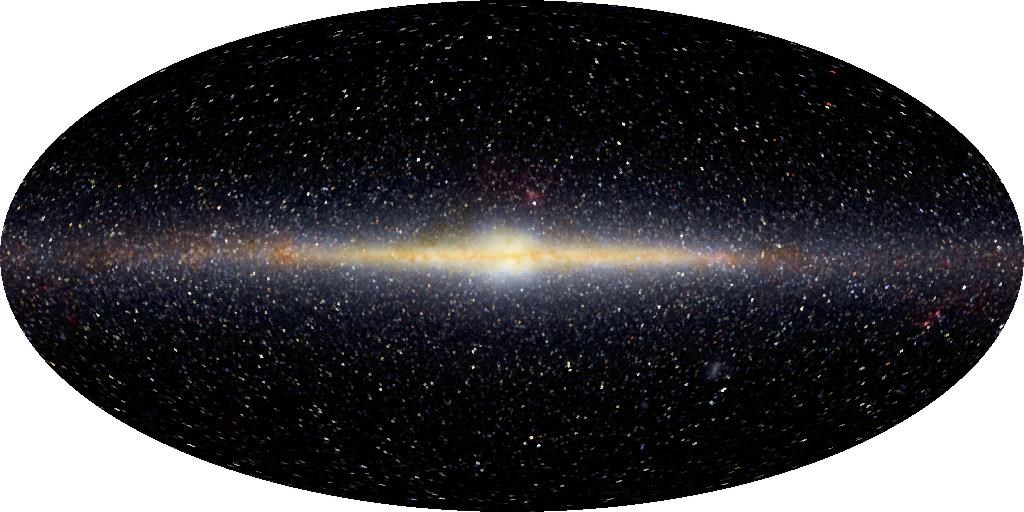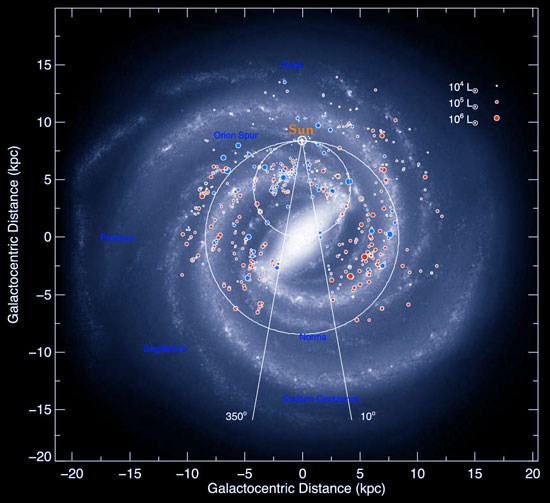Skynotes: February 2022
Upcoming events
Webb Space Telescope update
The new multi-billion dollar Webb infrared space telescope has performed flawlessly on its month-long journey and has now arrived at its destination 1.5 million km from Earth, the gravitationally stable location known as La Grange 2 or L2. During its transit it successfully unfolded and tensioned its five layered heat shield, deployed its solar array, radiator panel, communications antenna, secondary mirror, and lastly its golden primary mirror. The detailed sequences for all these intricate steps required well over 300 critical steps or mechanical actions, a failure of anyone of which could have doomed the telescope.
A final course correction has placed it exactly as planned. Over the next four months it will cool to a spaceside operating temperature of -233°C (-266°C for one key instrument). During this time its systems will be tested, calibrated and fine-tuned, and its primary mirror of 18 hexagonal segments will be brought into exact alignment. Only then will its exciting and potentially revolutionary science begin.
Explore more at
The Webb Mission, the appreciation of astronomy in general, and space missions in particular, are all greatly helped by accurate science visualisation and realistic animation – for the public and for scientists themselves. Animator Adriana Manrique Gutierrez at NASA’s Goddard Space Flight Center in Maryland is one of many working to benefit our enjoyment and understanding of science.
Enjoy an interview with Adriana:
Melbourne Sun times
| Date | Rise | Set | Day length | Solar noon* |
|---|---|---|---|---|
| Tue 1st | 6.33 | 8.33 | 13.59 hrs | 1.33 |
| Fri 11th | 6.44 | 8.23 | 13:38 hrs | 1.34 |
| Mon 21st | 6.55 | 8.11 | 13:15 hrs | 1:33 |
| Mon 28th | 7:03 | 8:01 | 12:58 hrs | 1:32 |
*When the sun is at its highest, crossing the meridian or local longitude.
Moon phases
| Phase | Date |
|---|---|
| New Moon | Tue 1st |
| First Quarter | Wed 9th |
| Full Moon | Thu 17th |
| Third Quarter | Thu 24th |
Moon distances
Moon apogee (furthest from Earth) is on Fri 11th at 404,896 km.
Moon perigee (closest to Earth) is on Sun 27th at 367,789 km.
Visible planets
Mercury returns to our eastern skies visible in the early dawn from 5am before fading by sunrise.
Venus is now back but as the ‘morning star’ rising in the dawn sky from around 4am and a little earlier each morning as the month progresses.
Mars has completed its pass behind the sun and will be visible from around 3.30am joining Mercury and Venus in our early morning skies.
Jupiter is now below the western horizon by evening as its orbit takes it behind the sun. The giant planet, third brightest object at night after the moon and Venus, will return next month in our early morning skies.
Saturn has just passed behind the sun but is still too close to the sun. The famous ringed planet will, however, become visible in the pre-dawn light from early April.
Meteors
The alpha-centaurids and beta-centaurids are active from 2nd to 25th peaking on the 8th. They are different but it is difficult to distinguish between them. Occurring near the Two Pointers they are not strong showers but often have fireballs and persistent trails. 25 per hour can occur but six per hour has been more usual.
Stars & Constellations
North-East to North-West
Orion, the hunter, is high in the north but seen in the southern hemisphere upside down. The famous three stars of his belt are Mintaka, Alnilam and Alnitak. These three bright stars in a row also go by many other names, including The Three Kings or The Three Sisters.
Sitting at an angle away from his belt (going upper right from our southern view) is a fainter line up which denotes his scabbard or sword. The central object in this line contains a fuzzy object which is the beautiful Orion Nebula. Binoculars can reveal a hint of this extraordinary star-forming region 1500 light years from us.
The central area of the constellation also gives us the asterism The Saucepan with Orion’s belt its base and his scabbard or sword its handle. Upper left is the blue-white supergiant star Rigel as one of his feet, and lower right is the red supergiant Betelgeuse marking one of his shoulders.
Lower in the north-west is the Hyades open star cluster of hundreds of stars 153 light years away. Its brightest stars make a wedge or inverted ‘V’ of stars that also forms the head of Taurus, the bull with the red giant star Aldebaran sitting at its lower right corner.
Below and to the left is the close grouping of blue giant stars 430 light years from us that formed together and are still bound together gravitationally. Over a thousand stars make up the cluster but it’s a small number of very bright stars that we see directly. This is the beautiful Pleiades star cluster or Seven Sisters. It’s M45 from Charles Messier’s catalogue. In many stargazing cultures this remarkable cluster does represent a group of women.
High in the sky is Sirius, the brightest star at night and the principal star in Canis Major (Greater Dog). This is one of Orion’s two hunting dogs which is why Sirius is also referred to as The Dog Star.
Around the world most night sky observing cultures have recognised its first evening appearance being important, marking special spiritual, agricultural or other significance during the year. As one of our sun’s nearby neighbours in the galaxy, being only 8.6 light years away, Sirius is over 25 times as luminous, with a name derived from the Greek seirios meaning (appropriately) glowing or scorching. It is accompanied by a faint small companion star, a white dwarf Sirius B. It is a binary star system - Sirius A and Sirius B with both stars orbiting each other every 50 years.
Here are two visual comparisons that give a dramatic sense of how different the two stars are in relation to own sun. Sirius A is bigger, brighter and hotter the sun, while little Sirius B is a massive as the sun it is actually smaller than Earth. These are good examples of how the characteristics of stars can vary enormously.
Sirius A is 1.7 times the size of the sun and twice its mass. Its 9000K surface temperature is also almost twice that of the sun, but its bigger surface area makes it brighter with a luminosity over 25 times that of our sun.
By comparison, the white dwarf Sirius B is roughly Earth-sized and has about the mass of the sun. But despite its 25,300K surface temperature being roughly five times that of the sun, its small size makes it only about a twentieth as luminous.
South-East to South-West
The Southern Cross and the Two Pointers, (Alpha & Beta Centauri) are low in the south-east. In the south-west are the two small nearby galaxies, the Magellanic Clouds, named in honour of 16th century explorer Ferdinand Magellan who embarked on the first circumnavigation of the globe. They look like faint fuzzy patches but are best seen away from city lights. They are visible all year round, unlike in equivalent latitudes in the northern hemisphere from where they cannot be seen. The earliest known physical depictions of them are in petroglyphs and rock art in South America.
The Milky Way’s broad band of billions of distant stars arcs across the sky from south through the east and to the north. Along its length lie several dark dust clouds that block light from distant regions of the galaxy.
Our view (at least in visible light) of the disc of the galaxy is largely restricted to the spiral arm in which we sit. We are looking ‘edge on’ into its dense flat disc. However, as we look either side away from the vast arc of stars and dust clouds we are looking through only a few thousand light years ‘above’ or ‘below’ the disc or plane of the galaxy. We see a small number of stars in those directions beyond which lies intergalactic space.
The disc of the Milky Way as seen edge on, which is how it appears to us at night as we are embedded in its flat plane.
The Sun marks our location in the vast disc of the galaxy which contains spiral arms that sit in its flat plane. At night our eyes see only the local area with most of the galaxy and its central region obscured by stars and dust clouds. When looking away from the band of stars at night we are seeing out of the galactic plane towards intergalactic space.
Enjoy a tour of our galaxy and some of the latest ideas of its shape at:
International Space Station
ISS orbits every 90 minutes at an average distance of 400 km. It appears like a bright star moving slowly across the night sky.
Some bright passes are below for the Melbourne region. On Saturday 12th it will pass overhead in the early morning and again in the evening giving two chances to spot it in one day!
Morning
- Fri 11th 5.50am-5.57am West-South-West to North-East
- Sat 12th 5.03am-5.09am South-West to North-East
Evening
- Sat 12th 9.43pm-9.49pm North-West to South-East
- Sun 13th 8.55pm-9.02pm West-North-West to South-East
Heavens Above gives predictions for visible passes of space stations and major satellites, live sky views and 3D visualisations. Be sure to first enter your location under ‘Configuration’.
On this day
1st 2003, the Space Shuttle Columbia (USA) disintegrated on re-entry killing all seven astronauts and halting the shuttle program for over two years.
1st 1970, US astronomer Vera Rubin finds evidence of ‘dark matter’ by studying motion of stars and galaxy rotation not consistent with Newton’s laws.
3rd 1996, Luna 9 (USSR) made first soft-landing on moon and sent first panoramic images from the Ocean of Storms.
4th 1976, Lunar Orbiter 3 (USA) launches to the moon to select Apollo landing sites.
5th 1963, Dutch astronomer Maarten Schmidt discovers quasars (quasi-stellar radio sources).
7th 1979, Pluto moves inside Neptune’s orbit for the first time since its 1930 discovery.
8th 1969, the Allende meteorite, the largest carbonaceous meteorite found, lands near the village of Allende, Mexico.
9th 1986, first module of Mir space station (USSR) is launched into Earth orbit.
9th 1986, last visit of Comet Halley met by flotilla of probes (notably ESA’s Giotto) with comet’s next return due mid-2061.
9th 1473, birth of Nicholas Copernicus, famous for his sun-centred theory in On the Revolutions of the Celestial Spheres (1543) which triggered the Copernican Revolution.
9th 1975, Soyuz 17 (USSR) returns to earth setting Soviet record of 29 days in space.
11th 2003, first measurements using WMAP (Wilkinson Microwave Anisotropy Probe) data to reveal relic Big Bang temperature as a variation across the universe.
12th 1947, 100 tonne iron meteorite falls in Sikhote Alin, southeast Russia. Largest in recorded history, brighter than the sun, with deafening sound and a smoke trail lasting several hours.
12th 1961, Venera 1 probe (USSR) launched to Venus by Soviet Union.
12th 2001, NEAR Shoemaker (USA) is first probe to land on an asteroid - 433 Eros.
13th 2004, discovery of ‘largest diamond’, white star BPM 37093, is announced.
14th 1990, Voyager 1 (USA) takes famous ‘pale blue dot’ picture of Earth as it looks back while speeding out of solar system.
15th 1564, birth of astronomer, physicist and engineer Galileo Galilei in Pisa, Italy. Supported heliocentric solar system, and studied motion, telescopes, moons of Jupiter, rings of Saturn, phases of Venus, Sun spots, and features of the moon.
15th 2013, 20meter Chelyabinsk meteor explodes 30km over Southern Urals, Russia, travelling at 60,000kph with shock wave damaging buildings and causing many injuries due to flying glass.
16th 1771, Charles Messier’s catalogue of 100 deep space objects.
17th 1965, Ranger 8 (USA) probe launched to image the moon in aid of Apollo landings.
18th 1930, Clyde Tombaugh (USA) discovers Pluto using a blink comparator in a systematic search for the supposed ‘Planet X’ beyond Neptune.
20th 1962, first American astronaut into orbit, John Glenn, in Mercury Friendship 7 in three orbits lasting almost 5 hours.
22nd 1632 Galileo publishes Dialogue Concerning the Two Chief World Systems which compared solar system models and led to conflict with and censure by the Catholic Church.
23rd 1987, SN1987A, closest and brightest supernova since 1054 observed in Large Magellanic Cloud 168,000 light years away. Visible to naked eye for months.
24th 1968, post-graduate student Jocelyn Bell (Northern Ireland) discovers first pulsars.
26th 1966, first Saturn 1B rocket launch, which led to Saturn V Apollo missions.
27th 1942, JS Hey (UK) discovered radio emissions coming from the Sun.
28th 1997, first evidence for gamma ray bursts (GRB) as extra-galactic energy sources.
